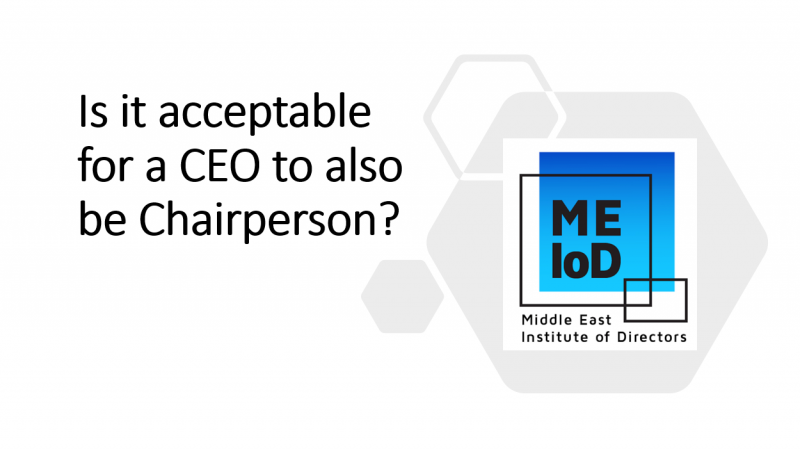Is it acceptable for a CEO to also be Chairperson

Is it acceptable for a CEO to also be Chairperson
It is still common globally for business leaders to be both CEO and Chairperson of the same company, although there is a trend towards separation. In 2016, just over 50% of companies in the S&P 500 Index were led by a dual Chairperson / CEO, down from 77% in 2001.
In MENA, the role is far less likely to be combined. A recent Hawkamah survey indicated that only 14% of regional businesses have a dual role. However, this does not take into account the prevalence of family businesses in the region. There is no clear data on this, however it is anecdotally common to have an elder family member, often the founder, as Chairperson, with the eldest child as CEO. This happens in all regions, however given that most GCC economies and many of the businesses within it are relatively young, this family dynamic is particularly potent.
Combining the CEO and Chairperson roles is not considered best practice and, traditionally the MEIoD recommends separating these roles – but it is important to note that no one size fits all.
The Risks
To understand the risks behind a CEO / Chairperson (or keeping both roles within the same family), it is important to understand that the role of the Chairperson, and the board, is to scrutinise the CEO and the management team as a whole.
This then provides perspective, guidance, risk management and assures external stakeholders, including potential investors, that senior management will not be able to take unchecked risks and that someone is making sure that they are representing the company’s best interests.
One example of an area which this could be an issue is executive remuneration. If the CEO also runs the board that sets the CEO’s salary, then it could easily be argued that minority shareholders do not have adequate representation or protection.
Time and perspective are also critically important. Chairperson and CEO both have intense roles that require different mindsets and complete commitment. The Chairperson should be taking a birds-eye view, doing a deep dive into areas of interest, whilst a CEO is tasked with the day to day operations of a company. Effectively switching between these two very different ways of looking at the business is extremely hard to do well.
Mitigation if You Have a Dual CEO / Chairperson Role
If you do decide to combine the CEO and Chairperson roles, or have familial ties between two holders of those roles, then there are a couple of things that you can do to mitigate the risks outlined above. It should be noted that the options below are recommended even for companies that do not have a dual role, however increase in importance for those that do:
Use Sub-Committees
Using sub-committees to address issues such as executive compensation and nomination of members to the board (Nomination and Remuneration committee) may reduce the conflict of interest issues that might otherwise arise when a CEO is setting their own pay. Moreover, it makes a diversity of appointments more likely. It is particularly important that there are people of different backgrounds and experience to challenge the CEO. If the CEO is appointing these directors, then there is the risk of conscious or sub-conscious bias, leading to cronyism and inadequate oversight.
Appoint Independent Directors
Independent directors do not hold stock in the company and as such are able to clearly focus on corporate governance and risk mitigation. It is important that these directors are appointed by the Nominations and Remuneration Committee rather than by a committee controlled directly by the Chairperson / CEO.
Having a strong lead independent director or independent vice-Chairperson is particularly important. Studies in the US, by organisations such as the NACD, have shown that an effective lead independent director can be extremely beneficial in situations where there is a dual role present. The lead independent director is a specific type of independent director whose primary role is to provide scrutiny of the board and Chairperson, much as the Chairperson has the primary responsibility for scrutinising the CEO and company management. In the case of a vice-Chairperson, he or she can lead the discussion in situations where there are issues relating to the Chairperson that cause him or her to step aside.
Combining the CEO and Chairperson roles is not considered best practice and, traditionally the MEIoD recommends separating these roles – but it is important to note that no one size fits all. However, it is important to acknowledge that where the roles of CEO and Chairperson are combined, there are ways to manage the situation that does not compromise stakeholders and consequently the company itself.
The Middle East Institute of Directors is a not-for-profit organisation offering regular workshops for directors. To learn more, please see our capacity building programs or contact us directly.
For More Information:
advisoryServices | capacityBuilding | webinars | knowledgeCenter | A-Look-At-Corporate-Governance-In-The-Context-Of-COVID-19 | 5-ESG-trends-that-should-be-on-your-radar | Corporate-culture-and-the-role-of-the-board | What-does-it-take-to-excel-in-the-boardroom | The-key-drivers-of-effective-corporate-governance | Which-type-of-board-structure-does-my-business-need | The-Importance-of-a-Code-of-Ethics-in-an-Organization | reducing-the-pressure-to-decide-in-the-boardroom | How-future-proof-is-your-board | How-do-you-tell-if-someone-is-qualified-to-sit-in-the-boardroom | What’s-your-position--what’s-your-heading—leading-vs-lagging-indicators | The-value-of-governance-for-SMEs | Getting-started-with-governance:-a-guide-for-SMEs | What’s-on-the-boardroom-agenda-in-2021 | Role-of-CFO-in-the-boardroom | The-Shape-of-Corporate-Governance-in-2023 | Updates-on-Corporate-Governance-in-the-Middle-East-–-April-2023 | 3-ways-that-corporate-governance-is-crucial-to-sustaining-family-businesses | How-governance-legislation-in-Abu-Dhabi-has-affected-family-owned-businesses | Boards-of-Directors-in-the-GCC:-Navigating-the-Aging-Boards-Issue | Board-Composition-Trends-in-GCC | Politics-in-the-Boardroom:-Navigating-Power-Dynamics-and-Decision-Making | Why-Startups-Need-Independent-Directors:-The-Key-to-Good-Governance-2 | The-role-of-the-chairperson-2 | How-board-remuneration-impacts-company-success-2 | The-value-of-a-family-constitution-for-family-owned-businesses-2 | 6-questions-board-members-should-be-asking-themselves-2 | Case-Study:-Lessons-from-a-Failed-Digital-Transformation-Implementation | 8-ways-boards-can-drive-effective-corporate-governance | How-committees-and-boards-interact-4 | Importance-of-Training-for-Directors | Advancing-Digital-Transformation-and-Cybersecurity-Governance-in-the-Middle-East | Strengthening-Stakeholder-Engagement-and-Communication-Across-the-GCC:-The-Critical-Role-of-Boards-in-Navigating-Shareholder-Activism | about | investors | director-nomination | corporate-governance-reporting | corporate-governance-assessment | 1-to-1-coaching-for-board-members | advisory-board-setup | board-evaluation | family | director-nomination | corporate-secretarial-services | corporate-governance-assessment | 1-to-1-coaching-for-board-members | board-evaluation | corporate-governance-reporting | individuals | director-nomination | 1-to-1-coaching-for-board-members | entrepreneurs | corporate-secretarial-services | corporate-governance-reporting | corporate-governance-assessment | 1-to-1-coaching-for-board-members | board-evaluation | advisory-board-setup | director-nomination
Share article




